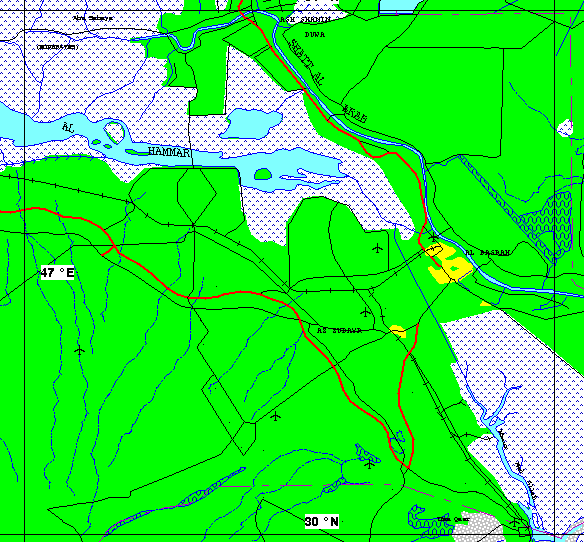



Basrah Presidential Site
30°30'N 47°50'E
The special group of UN Special Commission for Iraq (UNSOM) weapons inspectors, diplomats and representatives of the International Atomic Energy Agency (IAEA) completed its initial inspections of Iraqi presidential sites on 02 April 1998. It took eight days to complete the so-called baseline inspections of the presidential sites. Access to these sites, which Iraq had declared off limits to the United Nations, was granted only after Secretary General Kofi Annan signed an agreement with Iraqi President Saddam Hussein during his
visit to Baghdad last month which allows UN weapons experts, accompanied by a special group of "diplomatic observers," to inspect the compounds. Unfettered access to these and other sites is one of the conditions that must be met to complete the weapons inspections and ultimately lift UN sanctions.
All eight "presidential sites" visited appeared to be well defined by high walls or fences. They all had a rather
similar landscape pattern: main guesthouses, with an integrated system of ancillary buildings and villas for
accompanying dignitaries. Often an artificial lake with small artificial decorative islands located in a way to give
access to the lake from each guesthouse. The mission was not intended to be a search for prohibited material and none was found. In fact, there was very little equipment, documentation or other material in the sites at all. It was clearly apparent that all sites had undergone extensive evacuation. In all the sites outside of Baghdad, for example, there were no documents and no
computers. The buildings were largely empty. A key accomplishment of the mission was to plot more precisely the boundaries of the presidential sites.
The Basra palace is generally reported to be the smallest of Hussein's residences and is known for its Islamic buildings. A merchant's villa, it was built during the Ottoman period and overlooks the Shatt Al-Arab River. Other accounts suggest that the most impressive presidential residence is Qasr-Shatt al-Arab, a complex of buildings [said to be bigger than the palace at Versailles] and four artificial lakes built along the waterway that separates Iraq and Iran.
Three senior diplomats and 21 experts from UNSCOM and IAEA proceeded to Basrah in a road journey of over six hours and completed their visit to the presidential site on 30 March. They stayed the night in Basrah and returned to Baghdad on 31 March. The Head of the Special Group accompanied the experts in the helicopter. A formal request to land on site by UNSCOM experts was not acceptable to the Iraqi authorities on the grounds of
the special nature of the site and national dignity. Instead the helicopter landed in very close proximity to the site and the Head of the Special Group was provided with a vehicle to meet the experts and the senior diplomats on the site.

Sources and Resources
http://www.fas.org/nuke/guide/iraq/facility/basrah.htm
Maintained by Webmaster
Updated Monday, October 09, 2000 7:47:23 PM







